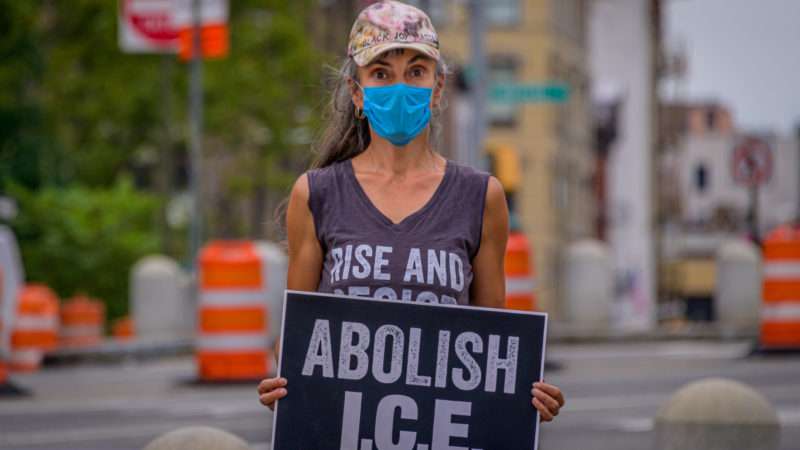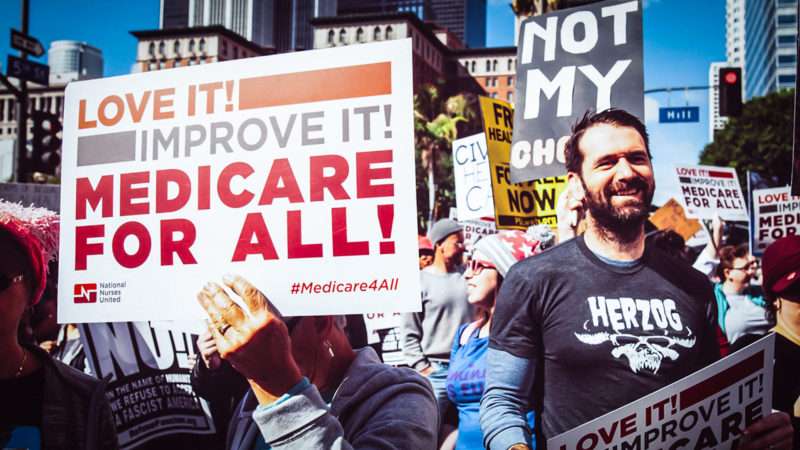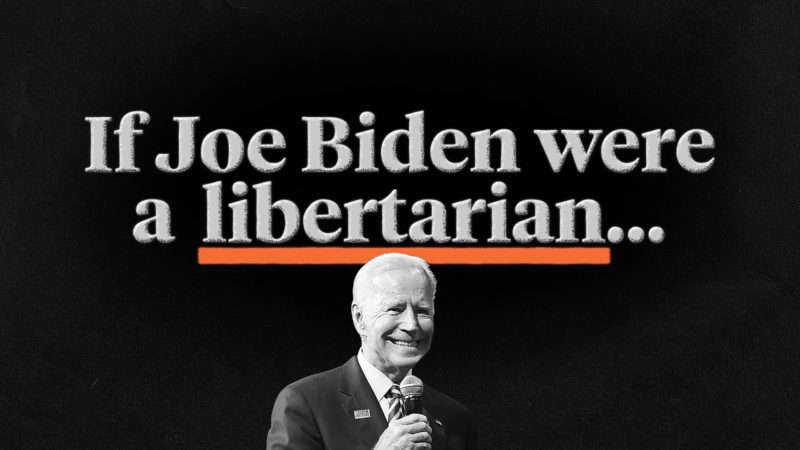Netflix’s Immigration Nation is a damning portrayal of Immigration and Customs Enforcement (ICE). And yet it is not damning enough! The directors of the six-part series, Christina Clusiau and Shaul Schwarz, got unprecedented access to the inner workings of the agency tasked with enforcing America’s Kafkaesque immigration system, but the most oppressive side of the agency—where sexual and other abuse occurs on a regular basis—remains hidden from the camera.
Still, the glimpse we get reveals an agency that thinks nothing of inflicting the cruelest punishment for the smallest offense, and sometimes for no offense at all—all because the people concerned were born on the other side of the border.
Given just how secretive ICE is, Clusiau and Schwarz pulled off a small miracle by using their pre-existing relationship with an ICE spokesperson to embed themselves in the agency just when President Donald Trump assumed office. For the next three years, they followed ICE around the country, from New York to Texas to Arizona, watching agents conduct raids, debate enforcement tactics, and plot media strategy while blithely upending—and ending—lives.
The documentary, whose more incriminatory parts the Trump administration tried to suppress, opens with a pre-dawn ICE raid on undocumented immigrants in New York. The raid marks the first day of the weeklong Operation Keep Safe—whose actual purpose, contrary to its name, was to instill fear. One ICE agent gushes as he gets ready for action: “I love my job.” A Hispanic agent, on the first day of his job, is giddy: “It’s Christmas for us.” Another exults that the change of administration means “it’s a different world now” where the “floodgates have opened.”
But who exactly is getting swept away? Not folks with serious criminal histories. ICE’s own records show that only 13 of the 225 people arrested during that operation had serious crimes on their record. The vast majority of those arrested either had committed minor misdemeanors, such as DUIs, or were that unfortunate breed called “collaterals.”
Collaterals are undocumented people who have committed only visa violations—akin to speeding in a rational world—but happened to be in the vicinity when ICE came looking for someone else. If any agent has qualms about going after them, those reservations dissolve as the pressure of filling arrest quotas kicks in. ICE agent Brian’s experience makes this abundantly clear. Just when he was expressing his distaste for the practice, he got a call from his supervisor, who tells him “I don’t care what you do” just “get me two” arrests.
None of this is news to anyone who follows the issue. But what’s jaw-dropping is to watch ICE agents openly bend and break the rule of law in the name of…enforcing the rule of law.
A typical Operation Keep Safe raid involved scores of agents surrounding an apartment building, stealthily climbing the stairwell, and banging on doors. By law, ICE agents can’t enter and arrest until they are asked in. So how did they obtain an invitation? By lying and identifying themselves as police. If someone protested on seeing who they really were, the reaction essentially was “Tricked ya!”. The agents then calmly go about the grim business of handcuffing dazed fathers (and sometimes moms) while ignoring the pleas of their shell-shocked spouses and wailing children.
Or that’s what the relatively well-behaved agents did. The really out-of-control ones went further. The documentary shows one attempting to break in by picking an apartment building’s lock, apparently unperturbed that he was being filmed.
Nor is that the worst of it.
In Charlotte, North Carolina, local immigration activists turned Sheriff Irwin Carmichael’s cooperation with ICE via the 287(g) program into a huge issue in his 2018 reelection bid. This program is essentially an ICE “force multiplier,” as one official puts it: It allows ICE to deputize local officers for enforcement purposes and use local jails to park unauthorized immigrants much longer than their original offense merits, until ICE whisks them away for deportation. (When some activists got into a heated exchange about this with an official at a press conference, he responded: “One more profanity and I’ll pick you up myself.”) The activists won, and Carmichael’s replacement scrapped the program on his first day.
ICE instantly started plotting reprisals. Over the ensuing weeks, it assembled 50 agents and created six transport teams to patrol Latino neighborhoods, often in unmarked cars, looking for anyone who looked unauthorized. Racial profiling was of course rampant. They stopped Latino work crews at traffic lights, intersections, and gas stations on the smallest of pretexts, such as a broken tail-light. Unless they claimed to be U.S. citizens, the agents would intimidate them into being fingerprinted on a mobile machine, arresting them on the spot if no match was found.
The upshot was even more terror. And that was exactly the point, as Bryan Cox, ICE’s public affairs spokesperson openly admitted. Anti-287(g) activists, he explained, have to be taught that scrapping cooperation with ICE will result in more—not fewer—deportations. “You thought we were bluffing and whatnot?” he smirked. “The whole goal here is to get them to change their policy.” Plainclothes off-duty ICE agents started attending activist meetings. ICE’s answer to Americans protesting its reign of terror against immigrants was a reign of intimidation against the protesters.
ICE and its sister agencies terrorize immigrants not just through its enforcement squads and detention camps, but by weaponizing its bureaucracy.
In recent days, reports have surfaced that immigration authorities—in an administration allegedly dedicated to slashing red tape—have quietly adopted a no-blanks policy that rejects visa applications if any part of a form is left unfilled. If someone does not have a middle name and skips that line, their petition gets thrown out. Ditto if they leave out the apartment number because they live in a house. The strategy is to make the process so hard for people who are trying to do it by the book that they abandon their quest to live in the United States.
One of the most heart-wrenching stories in Immigration Nation shows how the immigration bureaucracy chews up and spits out Carlos Perez. As a police officer in El Salvador, he offered intel on Salvadoran gangs to the New York Police Department. When the gangs found out, he and his wife fled, at one point swimming across a river with their two toddlers strapped to their backs. The precise details are a bit fuzzy, but it seems Perez sought asylum and was released into the country with work authorization, which he dutifully renewed on a regular basis. But his lawyer forgot to file a formal petition—something that occasionally happens because these migrants are too poor to buy quality representation and don’t have the language skills to navigate the byzantine system themselves. Many years later, when ICE realized this, it took Perez into custody. And after some months, ignoring his pleas that he’ll be killed if he returns home, sends him packing back. The fact that he had risked his life to help American law enforcement counted for nothing against his trivial lapse in paperwork.
At one point, we see him calling his family from a detention camp prior to deportation. He poignantly gives his son, a teenager who has to prematurely step into his dad’s shoes, instructions on making car payments and other such business. The ICE supervisor, who had total discretion over Perez’s fate, admits that Perez was trying to play by the rules. But in the end, he says, he gets “an inherent kind of satisfaction—I won’t say ‘joy’—in removing people who don’t belong in the country regardless of public sentiment.”
After Perez’s deportation, his son drops out of school, cashes in his meager savings, and tries to support the family. “I’ve lost all faith in the U.S. government,” he mourns.
The documentary also introduces us to Cesar Lopez, a U.S. marine veteran turned translator, who was refused entry when he tried to return from an assignment in Central America because he had a 12-year-old marijuana conviction on his record. He had to sneak back via Mexico to rejoin his wife. The only legal way for him to return would have been to die, because then his remains would be brought back for a military funeral.
Cesar’s story, unlike Perez’s, has a happy ending—one of very few in the series. After a herculean effort, he eventually gets a pardon from the governor of New Mexico.
When the administration adopted its zero tolerance policy, the filmmakers captured the horror show in real time because their crew happened to be at the El Paso detention center when it began. They capture scenes of grown men weeping uncontrollably because their kids had just been snatched from them. The story that will break every parent’s heart comes when a Honduran mother describes how her toddler behaved when he was reunited with her after months of separation. He would timidly raise his hand before asking her questions. Using the bathroom was stressful for him because he wasn’t toilet trained when he was ripped away, and whoever trained him used force.
And then there is the 63-year-old Guatemalan woman—petite, frail, terrified, and the furthest thing from a threat to the United States—who fled her country with her 12-year-old granddaughter. According the grandmother, an MS-13 gang member took a fancy to the preteen and demanded that grandma let him marry her or he’d kill them both. The two traveled for 10 days by land to reach the U.S. border and immediately turned themselves in at a port of entry, exactly as legally required. The granddaughter was released from detention after two months to join her mom, who lives in the U.S. The grandmother, however, was held in detention for 17 months—illegally, her lawyer claims, since she met the test for being released into the country while her asylum petition was considered. But she was a pawn in the Trump administration’s deterrence game, so the rules didn’t matter.
Her petition was eventually rejected. Before her lawyer could file an emergency appeal—as is perfectly in keeping with the rules—she was deported in the dead of the night. She wasn’t even allowed a phone call to bid her granddaughter good-bye.
Story after story in Immigration Nation shows how the government systematically games and breaks the rules to keep immigrants out. Yet one ICE agent smugly tells unauthorized immigrants, as he leads them to the bridge back to Mexico, to “try to do it the right way” next time, because, the right way is “always the best way.” He seems oblivious to the fact that even before Trump arrived on the scene and gutted legal immigration, few options to come in the “right way” existed for low-skilled migrants: Every administration since President Lyndon Johnson has been slamming doors in their faces.
Johnson scrapped the Bracero program that had allowed Mexican guest workers to come and go relatively easily, following the demand for their labor in this country. That program was never replaced with anything remotely analogous. (Currently, there is no queue where low-skilled migrants can wait to obtain a full-year legal work visa.) After President Ronald Reagan offered amnesty to the undocumented immigrants who had gathered in the shadows since the Bracero program ended, the incensed nativist right (along with leftist labor unions) browbeat President Bill Clinton into putting border enforcement ahead of visa reforms. Ever since, every president has doubled down on the first and backed off from the second in an effort to appease the restrictionists, who keep moving the goal post.
Clinton criminalized immigration, making nonviolent offenses that are relatively minor infractions under U.S. criminal law deportable aggravated felonies under immigration law. He also sealed off the San Diego corridor that migrants had commonly used to come to the United States. So instead they walked through the harsh Arizona desert, in extreme temperatures, without food or water, relying on human coyotes or smugglers—all of which the documentary captures in horrific detail.
The Clinton administration knew that rerouting the migrants would result in more deaths. Indeed, that was the point. The UCLA archeologist Jason De Leon, who excavates human remains in the desert, notes that one of the official metrics used to gauge the success of this “prevention through deterrence” policy was the number of migrant deaths. The government couldn’t go and shoot 3,000 migrants in the desert, he noted. But it thought nothing of consigning 3,000 migrants to their deaths if it could be chalked up to the travelers’ decision to put themselves in harm’s way.
One of the concluding stories in Immigration Nation features Camerina Santa Cruz, a Tucson-based mother whose 20-plus-year-old son, Marco, lived in Nogales, Mexico, 63 miles away—shorter than some Americans’ commute to work. Marco was denied a visa to join her in America. So he decided to make the schlep through the Sonoran desert with some buddies and disappeared. She kept waiting for him to show up for five years. Then one day she learned from the Pima County Medical Examiner that they had matched his DNA to partial remains they’d retrieved from the desert. We watch her drive to the examiner’s office, dressed all in black, to bring her son home.
Reason has long argued that immigrants who come to the United States to work hard and live in peace are an unmitigated blessing. But let’s assume, arguendo, that their economic and cultural costs make them a net negative. Would that make America’s border wars rational? Not too many who watch this documentary with an open mind and a heart would say yes. The series shows that the more America cracks down on the border, the more it has to crack down. Every round of brutality begets another, still more brutal round. There is no brutality equilibrium that can buy America lasting deterrence. As one unsentimental agent puts it, when it comes to hunting the “human species,” the hunter is always behind the curve because the prey is adapting faster than him. The border jumpers are always “a little bit smarter than you,” he says. So the hunter compensates for what he lacks in smarts by ratcheting up his brutality level.
That’s the tragic logic that Immigration Nation brilliantly captures.
from Latest – Reason.com https://ift.tt/2QdFyw3
via IFTTT





